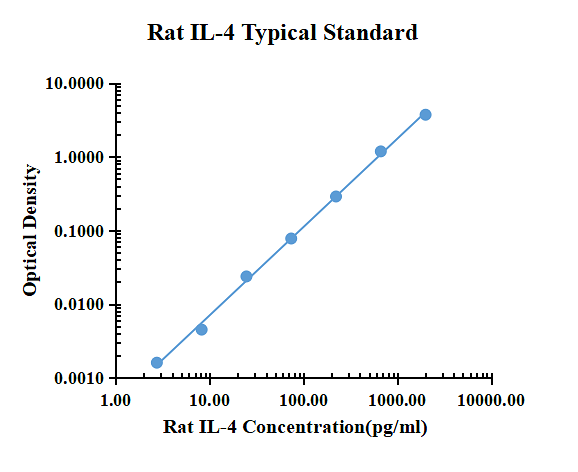Rat IL-4 enzyme-linked immunoassay kit
| Specification | 96 Test |
|---|---|
| Sensitivity | 17.29 pg/ml (50 μl) |
| Standard Curve Range | 2.74~2000 pg/ml |
| Standard Curve Gradient | 7 Points/3 Folds |
| Number of Incubations | 2 |
| Detectable sample | Liquid phase sample of soluble substances. For example: serum, plasma, cell culture supernatant, tissue grinding liquid, etc. |
| Sample Volume | 50 μl |
| Type | Fully Ready-to-Use |
| Operation Duration | 120min |

| pg/ml | O.D. | Average | Corrected | |
|---|---|---|---|---|
| 0 | 0.105 | 0.104 | 0.1045 | |
| 2.74 | 0.1086 | 0.1036 | 0.1061 | 0.0016 |
| 8.23 | 0.11 | 0.108 | 0.109 | 0.0045 |
| 24.69 | 0.1382 | 0.1433 | 0.1408 | 0.0767 |
| 74.07 | 0.2812 | 0.2953 | 0.2883 | 0.2242 |
| 222.22 | 0.6422 | 0.6543 | 0.6483 | 0.5842 |
| 666.67 | 1.5432 | 1.5153 | 1.5293 | 1.4652 |
| 2000 | 3.0881 | 3.1932 | 3.1407 | 3.0766 |
Precision
| Intra-assay Precision | Inter-assay Precision | |||||
| Sample Number | S1 | S2 | S3 | S1 | S2 | S3 |
| 22 | 22 | 22 | 6 | 6 | 6 | |
| Average(pg/ml) | 33.4 | 172.8 | 557.4 | 32.8 | 175.6 | 561.2 |
| Standard Deviation | 1.8 | 8.1 | 26.8 | 2.3 | 12.1 | 34.8 |
| Coefficient of Variation(%) | 5.4 | 4.7 | 4.8 | 7 | 6.9 | 6.2 |
Intra-assay Precision (Precision within an assay) Three samples of known concentration were tested twenty times on one plate to assess intra-assay precision.
Inter-assay Precision (Precision between assays) Three samples of known concentration were tested six times on one plate to assess intra-assay precision.
Spike Recovery
The spike recovery was evaluated by spiking 3 levels of rat IL-4 into health rat serum sample. The un-spiked serum was used as blank in these experiments.
The recovery ranged from 93% to 115% with an overall mean recovery of 105%.
Sample Values
| Sample Matrix | Sample Evaluated | Range (pg/ml) | Detectable (%) | Mean of Detectable (pg/ml) |
|---|---|---|---|---|
| Serum | 30 | n.d. | 0 | 0 |
Serum/Plasma – Thirty samples from apparently healthy rats were evaluated for the presence of IL-6 in this assay. No medical histories were available for the donors.
n.d. = non-detectable. Samples measured below the sensitivity are considered to be non-detectable.
Product Data Sheet
Background: IL-4
Interleukin-4 (IL-4), also known as B cell-stimulatory factor-1, is a monomeric, approximately 13 kDa ‑ 18 kDa Th2 cytokine that shows pleiotropic effects during immune responses. It is a glycosylated polypeptide that contains three intrachain disulfide bridges and adopts a bundled four alpha -helix structure. Human IL-4 is synthesized with a 24 aa signal sequence. Alternate splicing generates an isoform with a 16 aa internal deletion. Mature human IL-4 shares 55%, 39% and 43% aa sequence identity with bovine, mouse, and rat IL-4, respectively. Human, mouse, and rat IL-4 are species-specific in their activities.
IL-4 exerts its effects through two receptor complexes. The type I receptor, which is expressed on hematopoietic cells, is a heterodimer of the ligand binding IL-4 R alpha and the common gamma chain (a shared subunit of the receptors for IL-2, -7, -9, -15, and ‑21). The type II receptor on nonhematopoietic cells consists of IL-4 R alpha and IL-13 R alpha 1. The type II receptor also transduces IL-13 mediated signals. IL-4 is primarily expressed by Th2-biased CD4+ T cells, mast cells, basophils, and eosinophils. It promotes cell proliferation, survival, and immunoglobulin class switch to IgG4 and IgE in human B cells, acquisition of the Th2 phenotype by naïve CD4+ T cells, priming and chemotaxis of mast cells, eosinophils, and basophils, and the proliferation and activation of epithelial cells. IL-4 plays a dominant role in the development of allergic inflammation and asthma.

